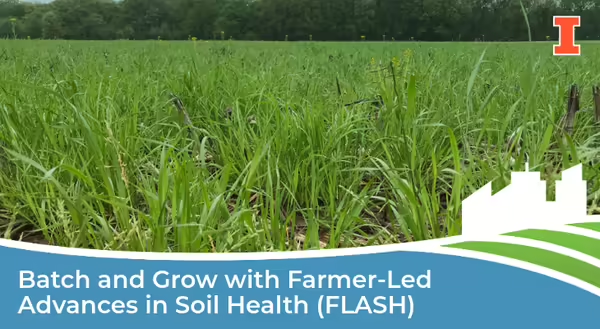
Farmers often learn best from one another, and the Farmer-Led Advances in Soil Health (FLASH) program helps make those connections possible. In episode 77, Morgan Cauble from American Farmland Trust (AFT), Malina Przygoda from the Coles County Soil and Water Conservation District, and Bobby Orman, a Coles County farmer, discuss the FLASH program and its Batch and Grow cover crop initiative.
What is FLASH?
FLASH is designed to create farmer-to-farmer networks within priority watersheds in Illinois. In the program, farmers identify local challenges, share their experiences, and collectively decide on the conservation practices that will best address issues in their watershed.
Currently, there are five active groups across Illinois, located in:
- Jo Daviess County
- Coles County
- Vermilion Headwaters (Livingston and Ford Counties),
- Hillsboro Lakes (Montgomery County)
- Black Slough watershed (Champaign County).
Farmers interested in participating in the program should contact their local Soil and Water Conservation District.
What is the batch and grow program?
The batch and grow program is a cover crop program available exclusively to FLASH participants. Cover crops are an in-field agricultural conservation practice that offers a range of benefits, including enhanced soil health and reduced nutrient loss.
The program is simple: Farmer leaders select mixes suited to the region, and AFT provides the seed and application at no cost to the participating farmers. The program is designed to reduce barriers during the early years of adopting the practice by offering technical support from farmer peers, a soil health specialist, and an agronomist, along with the free seed and application. To date, approximately 8,000 acres have been enrolled in the program.
A farmer’s perspective
Bobby Orman farms in western Coles County within the Lake Mattoon, Embarras River, and Kaskaskia River Watersheds. Orman was encouraged by the local NRCS and SWCD to join the local FLASH group because of the conservation practices he had already adopted. He acknowledged that wind and water erosion were obvious problems, and using cover crops would help address the issues. By joining FLASH, Orman notes that one of the benefits of participating in the program is the opportunity to establish strong networking connections with other farmers, agencies, researchers, and administrators.
FLASH connects farmers to:
- Other farmers implementing similar practices
- Local conservation professionals
- Researchers, agency staff, and program administrators
- Neighboring farmers facing the same resource concerns
This network allows for shared learning opportunities and problem-solving across the state. If a farmer is interested in participating in the program, Orman suggests gathering a few neighbors to identify a shared issue, which can be the foundation of a new group.
What’s next?
The goal for 2026 is to continue expanding the program, particularly in the Lower Wabash and other motivated watersheds. Future funding may support additional practices, such as nutrient management, no-till farming, and the establishment of habitat buffers.
To listen to the entire interview, go to episode 77 of the Illinois Nutrient Loss Reduction Podcast.
About the authors
Rachel Curry is an Agriculture and Agribusiness Educator specializing in agriculture and watershed education, and she is part of the Illinois Extension's Nutrient Loss Reduction Strategy implementation team. She holds a B.A. in Environmental Studies from Knox College and an M.S. in Environmental Science and Soil Science from Iowa State University, focusing on soil fertility. Her work centers on education and outreach related to the Illinois Nutrient Loss Reduction Strategy, promoting agricultural conservation practices that reduce nutrient loss while enhancing water quality and soil health across Illinois.
Nicole Haverback serves as a Watershed Outreach Associate and is an Illinois Extension team member implementing the Nutrient Loss Reduction Strategy. She holds a B.S. in Agricultural and Rural Policy Studies from Iowa State University. In her role, Nicole coordinates watershed management efforts aimed at reducing nutrient losses in two nitrate-nitrogen priority watersheds, offers expertise on best management practices to minimize nutrient loss, and leads outreach initiatives promoting agricultural conservation practices outlined in the Illinois Nutrient Loss Reduction Strategy.
Luke Zwilling serves as a Watershed Outreach Associate and is an Illinois Extension team member implementing the Nutrient Loss Reduction Strategy. He grew up on a farm in Jasper County and earned a B.S. in Agriculture and Biological Engineering from University of Illinois. Luke coordinates watershed-based activities to reduce nutrient loss in two phosphorus priority watersheds, provides expertise on best management practices for nutrient loss reduction, and conducts outreach on agricultural conservation practices in the Illinois Nutrient Loss Reduction Strategy.
About the blog
At Illinois Extension, we’re working to improve water quality at home and downstream. Every month, our Watershed Outreach Associates will bring you stories highlighting agricultural conservation practices, current research projects and results, and from the field farmer interviews. The Nutrient Loss Reduction blog covers conservation practices recommended by the Illinois Nutrient Loss Reduction Strategy, timely updates, farm safety, and new decision tools to help farmers and producers reduce the nutrients leaving their fields.